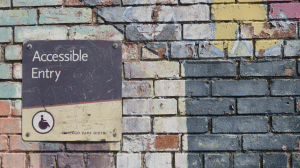Only those who address Ableism, i.e. discrimination against people with disabilities on an individual, cultural and systemic level, can counteract it and utilize the diverse skills of people with disabilities in companies. After all, adjustments in the recruiting process and an open approach to diversity are necessary to find undiscovered talent and reap the benefits of an inclusive workforce.
Often, companies claim that people with disabilities don't apply to them. But is that really the case? And if so, why is that? The following seven questions can help you reflect on this more closely:
1. Why don't enough people with disabilities apply to companies? Unreflective prejudices mean that people with disabilities are often disadvantaged. Because they grow up in separate educational systems, they receive poorer educational opportunities and thus have fewer opportunities in the general labor market. Only 30% of people with disabilities are employed in the general labor market. Education and qualification in the real world of work are necessary to get opportunities in the general labor market. People with disabilities have many reasons not to apply. These may be that wording in job advertisements puts them off or that the corporate culture does not appeal to them. Perhaps internalized rejectionism also causes them to be reluctant or the processes are not barrier-free.
2. Is the company actively and specifically looking for people with disabilities? Companies need to redesign their recruiting processes to specifically seek out people with disabilities. That's why companies need to formulate job postings in a way that people with disabilities feel addressed. Accessibility, both in the physical space and in the digital realm, is critical. To reach people with disabilities, companies need to network with initiatives that already support people with disabilities to work inclusively.
3. Are there exclusion criteria in the selection process that disadvantage people with disabilities? Recruiting processes must be reviewed internally to identify and eliminate barriers and exclusion mechanisms for people with disabilities. For example, how does the company handle gaps in resumes that may have occurred due to hospitalization or rehab? Do internship experiences take into account that people with disabilities have less access to them and therefore have few internships? Are spelling errors also a criterion for exclusion for a person who is open about their dyslexia? It is important to be aware of disabilities, barriers and support options and to be flexible in dealing with people with disabilities and their needs. Mutual open interaction, communicating strengths and weaknesses and possible support needs, enable people with disabilities to participate fully and equally in the labor market. This also includes providing people with disabilities with personal support and such as assistance or sign language interpretation and all available technical aids.
4. Does the company invite qualified applicants from underrepresented minorities for interviews before not diverse candidates? Sounds bold, but yes, companies should think about giving preference to inviting disadvantaged individuals to promote diversity and inclusion. This gives them a chance to find qualified employees who don't fit the typical mold. Barriers for people with disabilities can be lowered by providing alternative ways to apply. This can ensure accessibility in the application process. If a company hires a person who brings a different perspective to the team, don't say you hired them because of their diversity characteristic. If that was a factor in the decision, then you hired her because her perspective means she can or knows something different than other applicants and is therefore the best candidate for the job.
5. Does the company actively address the unconscious biases and fears of HR professionals? HR professionals should address their biases in order to provide equal opportunities to people with disabilities. Trainings and workshops can help to identify unconscious prejudices and counteract them. For example, test yourself here.
6. Does the company create an inclusive climate? After hiring a person with a disability, inclusion efforts are not over and must continue. How management and colleagues interact is critical to the professional success of people with disabilities. It is important to promote open communication and make the workplace accessible. This does not happen on its own. Here, too, it is important to take a close look at the corporate culture and ensure greater inclusion through coaching, training, and continuing education. When organizing events such as Christmas parties or team-building activities, care should be taken to ensure that everyone can participate.
7. Does the company offer the possibility to report discrimination - without fear of negative consequences? Companies need processes for reporting discrimination and finding solutions. Sensitivity, confidentiality and data protection are essential. Training and transparent agreements can help prevent and combat discrimination. Discrimination, especially in relation to disability, is often dismissed as perceived and insurmountable barriers. Only if we recognize and name discrimination as such can we take active action against it.
If you deal with these seven questions and see inclusion as a human right and not as a nice extra for people with disabilities, then we will come a little closer to an inclusive working world.
With our Belonging column we would like to give more space and visibility to the topics of anti-discrimination, belonging and intersectionality in the workplace together with our friends from LichtBlick. Our columnists for 2023 are the dedicated activists of SOZIALHELDEN e.V. with a focus on disability & intersectionality in the workplace. Through articles, interviews and different perspectives we want to challenge and inspire ourselves and all those working in the impact sector. And at the same time, encourage you to create authentically lived workspaces that promote belonging and reduce discrimination. By gaining new perspectives and engaging in collaborative dialogue, we can take a collective step toward radical systems change in the impact sector - from "power over" and "power for" to "power with."






